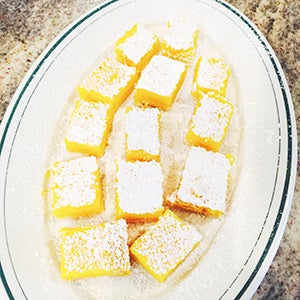When life gives you lemons, make lemon bars
Published 1:04 pm Saturday, April 16, 2016
The origin of citrus is uncertain. China is the most likely origin of the lemon. The Arabs had certainly introduced the lemon and the sour orange to Palestine and Persia by the beginning of the 12th century and from there to other Arab possessions in Spain and North Africa.
We can grow satsuma oranges in the open ground in our area and after a few years a tree can produce more than you can eat.
Lemons are a different matter. I really prefer to harvest my big juicy Meyer lemons rather than the commercial lemons available in the grocery. Two cultivars dominate the commercial market: Garey’s Eureka and Lisbon. Most lemons can be harvested throughout the year. Lemon trees do not become dormant in the winter and tend to produce some flowers throughout the year. However this makes them more vulnerable to cold weather than oranges and they will usually shed their foliage if the temperature drops below 23 degrees and fruit can be badly damaged below 28 degrees and serious damage can occur to the wood when temperatures fall below 19 degrees. Improved Meyer is slightly hardier than true lemon and may be a better choice for home gardeners in a cold climate. Meyer lemons are actually a hybrid between a lemon and a mandarin or an orange. It was first found growing as a pot plant near Beijing, China in 1908 by Frank Meyer, a plant collector for the US Department of agriculture. In the 1940s the Meyer lemon was discovered to be a carrier of a citrus virus. In the 1950s California-based Four Winds Growers discovered a virus-free clone and this was released to the market as ‘Improved Meyer’ in the 1970s.
Citrus do not do well as house plants. Our homes are too dry and not sunny enough. But I have found growing them in pots to be satisfactory. In our climate the pots may be left out all year, particularly if in a warm spot. We have few hard frosts and rarely do they last long. If you can move your pots into the garage or similar space for the short time that the temperature is bad, you can have some success with lemons.
Most mature citrus trees do well in a 15-in. pot. They definitely prefer a terracotta pot because it is porous and good drainage in essential. The main disadvantage of the terracotta is its weight. Citrus grow better in a loam-based (soil-based) material which is well aerated and provides good drainage. The best pH for citrus is between 6.0 and 7.0. Citrus need a number of trace elements if they are to grow well. One expert recommends Vigoro Citrus and Avocado Granular Plant Feed which can be had from Home Depot.
Careful watering is extremely important with citrus. They should be watered until the soil is soaked but drainage is essential. Do not allow to stand in water. Water with rain water if you can.
So if you want some very nice lemons that you cannot buy in the grocery, get yourself a 15-in. terracotta (or other if weight is a big problem) and buy a ‘Improved Meyer’ tree and get started this spring for fruit this fall and winter.
Lemons remind me of spring. If we didn’t have lemons there would be no lemonade and no lemon bars. I love the sweet-tart flavor of lemon bars. I found a recipe created by Chef Dolester Miles (pastry chef at the Highlands Bar and Grill in Birmingham) and she admits she likes all things lemony and this is her go-to classic version of lemon bars.
I am having a meeting of the Norwood Women’s Club this week (Norwood is just down the road in Louisiana) and for my afternoon tea I am serving these lemon bars for one of my treats.
From ‘Palate’ magazine/March 2016
Classic Lemon Bars
Makes 16 squares
For Crust
¾ cup flour
1/3 cup plus 1 tablespoon confectioner’s sugar
¼ cup cornstarch
½ teaspoon salt
8 tablespoons unsalted butter, chilled
For filling
6 eggs
1 ½ cup sugar
1 cup fresh lemon juice
1 teaspoon lemon zest
6 tablespoons flour
¾ teaspoon baking powder
¾ teaspoon salt
Preheat oven to 335 degrees.
In food processor, pulse flour with confectioner’s sugar, cornstarch, salt, and zest. Add butter, and pulse until mixture resembles coarse crumbs.
Line bottom of 9-inch square pan with parchment paper. Press dough into bottom of pan, and then refrigerate 15 minutes.
Bake until crust is lightly browned, approximately 20 minutes. Remove from oven.
Reduce temperature to 325 degrees.
Meanwhile, beat eggs with sugar in medium bowl. Add lemon juice, zest, flour, baking powder, and salt.
Pour filling over hot crust, and bake until filling sets, about 20 minutes.
Remove from oven, and cool to room temperature. Place in refrigerator and chill for about an hour before cutting. Sprinkle with confectioner’s sugar.






